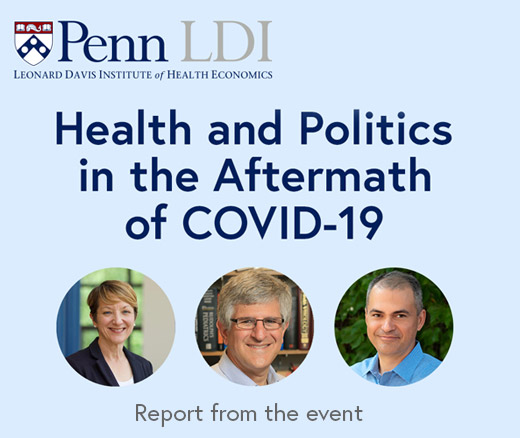
Contradictions That Confuse Federal Food Policies
Announcing Bold New Goals While Crippling the Infrastructure Needed to Achieve Them
Population Health
Blog Post

The largest national randomized controlled trial of payment incentives to improve health and lengthen life for people with end-stage renal disease (ESRD) is underway. LDI Senior Fellows Vishnu Potluri, Yuvaram Reddy, and Amol Navathe say the 2021-2027 ESRD Treatment Choices (ETC) model needs adjustments to meet its goals.
More than 800,000 people in the U.S. live with ESRD or kidney failure and need dialysis or a kidney transplant to stay alive. Transplantation has better outcomes, but only 13% of people with ESRD are on the growing kidney transplant waitlist. People who are Black, Hispanic, or in other minority groups are more likely to have ESRD but less likely to receive a transplant.
The ETC model compares standard payment policies for dialysis centers and their nephrologists to payment incentives for improvements, such as transplant rate. Equity incentives promoted by researchers reward progress in groups with socioeconomic disadvantages, which have high proportions of minoritized individuals. ETC incentives cover 30% of the country and are separate from national modernization of the transplant network, with independent results.
Reddy, Potluri, Navathe, and coauthors evaluated whether ETC is meeting its goal of increasing access to transplantation by comparing the number of patients added to the transplant waitlist under the control policies versus ETC.
The researchers analyzed waitlist additions in three time periods: January 2017 through February 2020 (before ETC), March 2020 through December 2020 (during the COVID-19 pandemic), and January 2021 through June 2022 (during ETC, after the pandemic). They measured changes in waitlist additions compared to the previous month, and changes in the rate of additions per month. Data were from the national Organ Procurement and Transplantation Network that oversees and coordinates transplants.

The study found no significant impact on the rate of additions to the kidney transplant waitlist. Before the pandemic and ETC, waitlist additions increased steadily. As expected, waitlist additions dropped dramatically from February to March 2020. Waitlist additions recovered fairly rapidly to approximately pre-pandemic levels by January 2021 when ETC was implemented. After ETC, the rate of additions to the waitlist flattened relative to the pandemic period, for both control and ETC model centers.
Month-to-month additions to the transplant waitlist did not improve over the 18-month period for either group. The researchers examined whether the ETC model affected equitable access to the transplant waitlist, but found no significant differences in waitlist additions by Black, Hispanic, or White race or ethnicity.
The study indicates that ETC has yet to increase accessibility or equity of the kidney transplant waitlist. The authors caution that the model might need more time to show effects. Health systems may still be resolving backlogs in waitlist referrals that paused during the COVID-19 pandemic. Also, getting on the waitlist is lengthy and complex for patients, Potluri said, with bureaucratic and other barriers.
The researchers recommended ways for the Centers for Medicare and Medicaid Services (CMS) to increase equitable access to kidney transplants.
1. Direct incentives to transplant centers. Potluri, Reddy, Navathe, and colleagues say that hospitals that perform transplants might be more effective than dialysis centers at making structural changes to increase transplantation. They are more directly involved in getting patients on the waitlist and arranging transplants.
A CMS payment model, the Increasing Organ Transplant Access (IOTA) model, which begins July 1, 2025, creates hospital-level bonuses or penalties for metrics such as number of transplants and care quality. Although adding models may increase administrative complexity, IOTA and ETC together have the potential to create a more comprehensive approach to increasing transplant access, Reddy said.
2. Use ETC evaluations to improve IOTA. The researchers say CMS should invest more time and resources into understanding ETC limitations, using the results to improve IOTA. They recommend interviewing and surveying dialysis center personnel, nephrologists, and patients about their ETC experiences. “We hear from nephrologists that they don’t know if their center was part of the ETC model, or how the payment incentives work,” Reddy said. “A better understanding of how to empower health care systems to participate in these payment models could lead to better rollout of IOTA and increased participation success.”
Give transplant centers time to prepare for changes, Potluri added. Ongoing evaluation of ETC, IOTA, and other payment models is critical to understanding which incentives change transplant rates.
3. Encourage local efforts to address inequities. CMS should continue to advance equity initiatives as they deploy new payment models, the researchers said. Under IOTA, transplant centers create a health equity action plan so each center addresses local disparities through culturally tailored interventions to groups underrepresented on the waitlist.
Through the newly launched Parity Center, Reddy, Potluri, and Navathe continue to study how to improve ESRD treatment. In an LDI initiative, Potluri is working to help patients navigate getting on the transplant waitlist. Reddy partnered with patients to raise awareness about the need to increase access to home dialysis, which is also part of the ETC model, and led a study to identify major barriers to home dialysis. He collaborates on an LDI Research Initiative to understand the impact of new value-based kidney payment models and test a community health worker-focused intervention for people with kidney disease.
The study, “Early Effects of the End-Stage Renal Disease Treatment Choices Model on Kidney Transplant Waitlist Additions,” was published on October 16, 2024 in the Clinical Journal of the American Society of Nephrology. Authors include co-first authors Vishnu S. Potluri and Yuvaram N.V. Reddy, and Sri Lekha Tummalapalli, Chen Peng, Qian Huang, Yueming Zhao, Genevieve P. Kanter, Jingsan Zhu, Joshua M. Liao, and Amol Navathe.


Announcing Bold New Goals While Crippling the Infrastructure Needed to Achieve Them

Promising New Evidence and What’s Next

From 1990 to 2019, Black Life Expectancy Rose Most in Major Metros and the Northeast—but Gains Stalled or Reversed in Rural Areas and the Midwest, Especially for Younger Adults

A Penn LDI Seminar Focuses on Why They’re Important for the Future

Former Philadelphia Health Commissioner Warns That Gutting the CDC, Undermining Vaccines, and Politicizing Science Will Leave the U.S. Dangerously Unprepared for the Next Pandemic

Rural Parents Had More Emergency Visits and Insurance Loss Than Urban Peers, an LDI Study Shows. Integrated Baby Visits Could Help All Parents Be Healthier